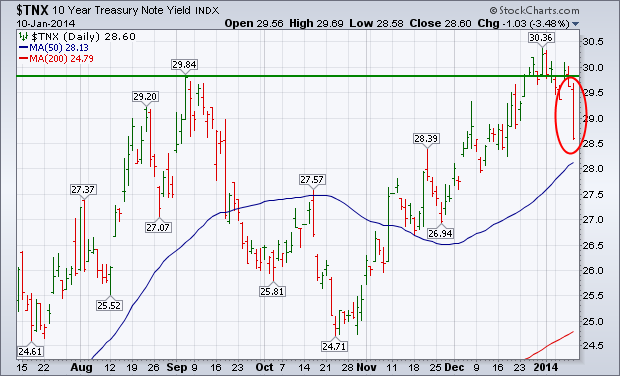Friday's news that American employers added only 74,000 jobs in December didn't have much of an effect on the broader stock market, but did shock bond investors. Chart 1 shows the 10-Year Treasury Note Yield ($TNX) suffering the worst drop since September. In so doing, the yield fell back below its early September peak just below 3%. Friday's plunge kept bond yields within its second half trading range between 3% on the upside and 2.5% on the downside. Bond prices jumped sharply as yields fell. Stocks tied to bonds also had a strong day. They include bond proxies like utilities and REITS. Homebuilders also had a strong day, as did dividend-paying stocks. So did gold and other precious metals. All had been hurt during 2013 by rising bond yields. Friday's action may have been an over-reaction to one month's report (most likely influenced by bad December weather). Portfolio rebalancing may have also played a role. One of the time-honored practices is to "rebalance" one's portfolio at the start of a new year. That involves moving some funds out of the previous year's winners (like stocks) and into the biggest losers (which are bonds). Some money managers are suggesting, however, that some money earmarked for bonds might be better placed in stock categories tied to bonds. The reasoning is that "bond proxies" offer the possibility of capital appreciation if stocks continue to rally. Since those groups were underperformers during 2013, they may offer better value at current levels, and some protection against an over-extended stock market that is entering a dangerous year.
RECAP OF 2014 FORECAST ... My December 14 message described a likely scenario for the presidential cycle to play out during 2014 which I'll summarize here. According to the Stock Traders Almanac, the second year of a presidential cycle (2014) is usually the most dangerous. The historical tendency is for the midterm election year to experience a correction (in the 15-20% range) between April and October. That usually leads to a major buying opportunity which most often leads to a stronger market the following year. I also pointed, however, that January and April were two of the best months to consider taking some profits (or rotate into more defensive sectors). January ends the best "three-month span" of the year that started in November. April ends the "best six-month span" that also starts in November. Of those two months, April is the more significant. Given that scenario, and following this week's market action, it may not be too early to start doing some "re-balancing" away from aggressive stock holdings that had a strong 2013 into more defensive stocks categories that pay dividends and that have lagged behind the market. Those groups include utilities, REITS (and especially homebuilders). That more defensive strategy may become more urgent if the market holds up through April. This may be one year where the "sell in May" strategy carries a lot more meaning.







